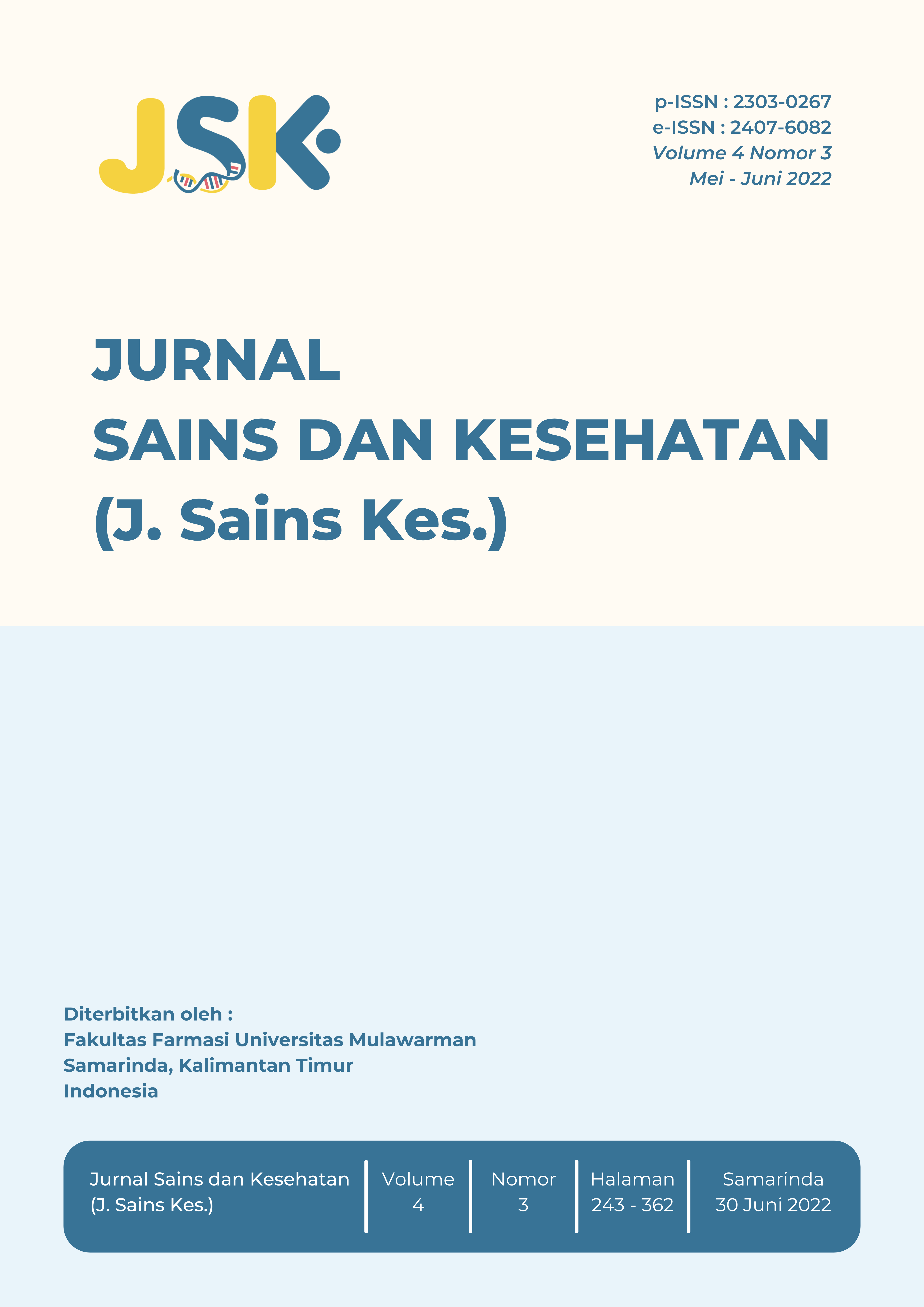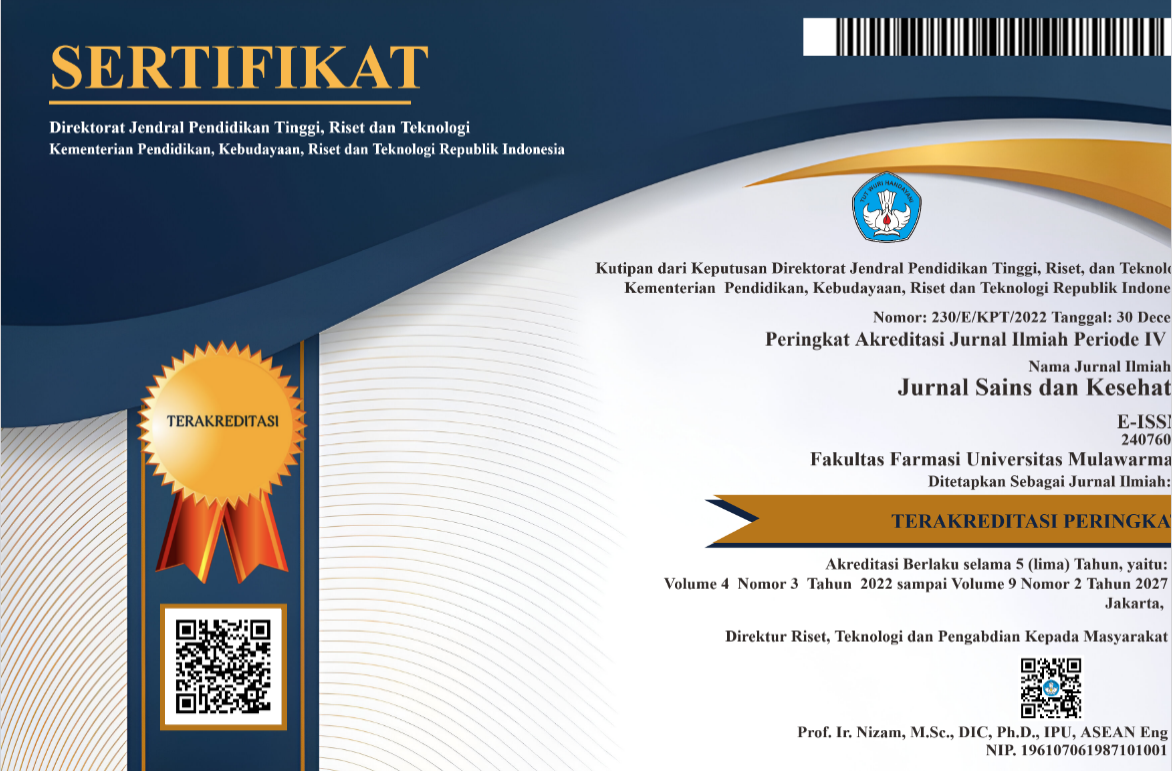Karakteristik Fisik Morfologi, pH, dan Waktu Alir Serbuk Serat Ampas Kelapa sebagai Bahan Pengisi Sediaan Farmasi
Physical Characteristics Morphology, pH, and Flow Time of Coconut Pulp Fiber Powder as a Filling Material for Pharmaceutical Preparations
Keywords:
Ampas kelapa, Bahan pengisi sediaan farmasi, Karakteristik fisik morfologi, pH, Waktu alir serbuk seratAbstract
References
Direktorat Jenderal Perkebunan, Statistik perkebunan indonesia 2015-2017: Kelapa (coconut). Jakarta: Kementerian Pertanian, 2017.
W. Miskiyah, I., Mulyawati, & Haliza, “’Pemanfaatan ampas kelapa limbah pengolahan minyak kelapa murni menjadi pakan,” in Seminar Nasional Teknologi Peternakan dan Vertenier, 2006, pp. 881–883.
M. F. Putri, “Kandungan gizi dan sifat fisik tepung ampas kelapa sebagai bahan pangan sumber serat,” TEKNOBUGA J. Teknol. Busana dan Boga, vol. 1, no. 1, pp. 32–43, 2014.
Wulandari, I. G. Yudha, and L. Santoso, “Kajian pemanfaatan tepung ampas kelapa sebagai campuran pakan untuk ikan lele dumbo, clarias gariepinus (Burchell, 1822),” e-Jurnal Rekayasa dan Teknol. Budid. Perair., vol. 6, no. 2, pp. 713–718, 2018.
M. R. Arumugam, B. Johson, and K. Eagappan, “Dietary fiber isolate from coconut flakes-a function food,” Int. J. Pharm., vol. 25, no. 2, pp. 261–267, 2014.
M. Cespi et al., “Evaluation of Citrus Fibers as a Tablet Excipient,” AAPS PharmSciTech, vol. 15, no. 2, pp. pages279–286, 2014.
R. Yulvianti, M., Widya, E., Tarsono, M., & Alfian, “Pemanfaatan Ampas Kelapa sebagai Bahan Baku Tepung Kelapa Tinggi Serat dengan Metode Freeze Drying,” J. Integr. Proses, vol. 5, no. 2, pp. 1-1–107, 2015.
A. Santoso, “Serat Pangan (Dietary Fiber) dan Manfaatnya Bagi Kesehatan,” Magistra, vol. 23, no. 78, pp. 35–40, 2015.
E. Anwar, Eksipien dalam Sediaan Farmasi. Jakarta: Dian Rakyat, 2012.
R. C. Rowe, P. J. Sheskey, and M. E. Quinn, “Handbook of pharmaceutical excipients,” in Handbook of Pharmaceutical Excipients, 6th ed., Washington D.C: Pharmaceutical Press and American Pharmacists Association, 2009.
L. Hadisoewignyo and A. Fudholi, Sediaan solida. Yogyakarta: Pustaka Pelajar, 2013.
M. E. Aulton, Pharmaceutics the science of dosage form design. London: Churchill Livingstone, 1988.
P. D. Pawar, P. M. Arane, H. B. Saindane, S. G. Talele, G. Shinde, and G. Chaudhari, “Review on pharmaceutical excipients,” Am. J. Pharm. Heal. Res., vol. 3, no. 2, pp. 30–50, 2015.
Downloads
Published
Issue
Section
How to Cite
Similar Articles
- Damaranie Dipahayu, Frisca Nadya Rachmawati, Devy Safitri, Formulasi Granul Instan Ekstrak Etanol Daun Ubi Jalar Ungu (Ipomoea batatas L.) Varietas Antin-3 , Jurnal Sains dan Kesehatan: Vol. 4 No. SE-1 (2022): Spesial Edition J. Sains Kes.
- Tias Eka Rahmawati, Intan Martha Cahyani, Siti Munisih, Karakterisasi Pati Bonggol Pisang Kepok Kuning (Musa paradisiaca L.) sebagai Bahan Tambahan Sediaan Farmasi , Jurnal Sains dan Kesehatan: Vol. 5 No. 2 (2023): J. Sains Kes.
- Deni Rahmat, Dian Ratih L., Liliek Nurhidayati, Meilda Ayu Bathini, Peningkatan Aktivitas Antimikroba Ekstrak Nanas (Ananas comosus (L.). Merr) dengan Pembentukan Nanopartikel , Jurnal Sains dan Kesehatan: Vol. 1 No. 5 (2016): J. Sains Kes.
- Hilmiati Wahid, Andi Juaela Yustisi, Prayitno Prayitno, Aninditya Dwi Lestari Amir, Formulasi Serbuk Effervescent Limbah Tulang Ikan Bandeng (Chanos chanos) sebagai Supplement Kalsium Tulang , Jurnal Sains dan Kesehatan: Vol. 5 No. 5 (2023): J. Sains Kes.
- Astrid Indalifiany, Suryani Suryani, Vica Aspadiah, Rifa’atul Mahmudah, Rezki Annisa, Formulasi Gel dari Niosom Elastik Span 80 Ekstrak Etanol Rimpang Etlingera alba dengan Variasi Karbopol sebagai Gelling Agent , Jurnal Sains dan Kesehatan: Vol. 5 No. 5 (2023): J. Sains Kes.
- Astrid Indalifiany, Waode Sitti Zubaydah, Elvira Riskiyani Kasim, Formulasi Spray Gel Ekstrak Etanol Batang Etlingera rubroloba Menggunakan HPMC sebagai Gelling Agent , Jurnal Sains dan Kesehatan: Vol. 5 No. 2 (2023): J. Sains Kes.
- Asti Vebriyanti Asjur, Elvira Santi, Tamzil Azizi Musdar, Syaifullah Saputro, Rosmiati Anggraini Rahman, Formulasi dan Uji Aktivitas Antioksidan Sediaan Face Mist Ekstrak Etanol Kulit Apel Hijau (Pyrus malus L.) dengan Metode DPPH , Jurnal Sains dan Kesehatan: Vol. 5 No. 3 (2023): J. Sains Kes.
- Wisnu Cahyo Prabowo, Wahyu Widayat, Synthia Defriana, Formulasi Infusan Daun Sirih Merah (Piper crocatum) sebagai Gel Antiseptik Tangan , Jurnal Sains dan Kesehatan: Vol. 1 No. 10 (2018): J. Sains Kes.
- Nuur Aanisah, Evi Sulastri, Yusriadi Yusriadi, Friskilla Friskilla, Armini Syamsidi, Pemanfaatan Ekstrak Buah Kaktus (Oputian elatior Mill.) sebagai Pewarna Alami pada Sediaan Lipstik , Jurnal Sains dan Kesehatan: Vol. 2 No. 4 (2020): J. Sains Kes.
- Lisna Meylina, Arsyik Ibrahim, Laode Rijai, Kajian Konsentrasi Ekstrak Daun Sirih Merah (Piper crocatum) sebagai Bahan Aktif Antiseptik dalam Sediaan Sabun Padat , Jurnal Sains dan Kesehatan: Vol. 3 No. 6 (2021): J. Sains Kes.
You may also start an advanced similarity search for this article.




